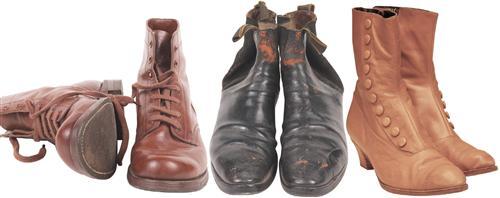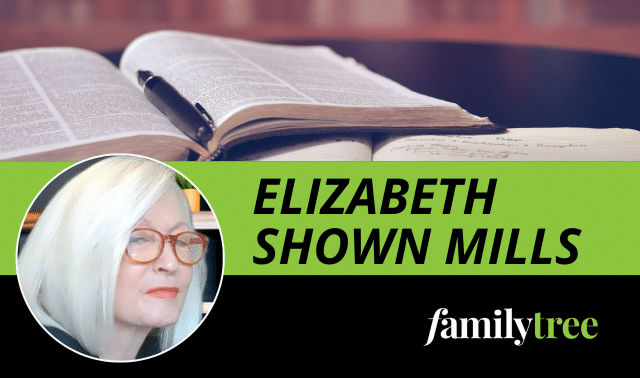Sign up for the Family Tree Newsletter! Plus, you’ll receive our 10 Essential Genealogy Research Forms PDF as a special thank you.
Get Your Free Genealogy Forms
"*" indicates required fields

You’ve heard the expression “We’re all in this together.” Well, just like you, your ancestors were part of a family, with siblings and cousins, aunts and uncles, parents and grandparents. Groups of relatives often lived near one another, worshipped together, witnessed one another’s documents and were laid to rest in the same cemetery.
Like you, ancestors had friends and neighbors. Their spouses frequently came from neighboring families or were the siblings of classmates and military buddies. They and their friends were lodge brothers or officers in the ladies’ literary society.
Your ancestors had business partners and co-workers, were clients of local doctors and lawyers and bought dry goods from the local mercantile store. They were known in their communities and occasionally got their names in the local newspapers.
Sometimes even small communities had several families by the same surname. When you start researching, you may not know whether these same-name families were related to yours. They may have been, and you could benefit from finding out.
Studying your ancestors in the context of their community of relatives, friends, neighbors, associates and same-name families is practicing “cluster genealogy,” an excellent method for tracing those elusive forebears. Here’s how it works.
1. Going from A to B by way of C
Studying an ancestral community-a cluster-often helps you learn more about individual ancestors. For example, if the mercantile store owner’s descendants placed his business ledgers in a local archive, you may learn what your ancestors purchased and when, whether they paid their bills on time, and whether they bought ready-made clothes or fabric for making garments at home. Each record of an ancestor’s shopping excursion proves that he or she was alive and in that place at that time.
Or consider families of the same surname. If census records show three Smitherman families in the same community, and one was yours, you need to learn whether the others were related to your Smithermans. The Smitherman men may have been brothers, or father and sons, or cousins, or not related at all. Studying such families along with your own could help you learn such things as a female ancestor’s maiden name or where your family lived before moving to that community.
Sometimes studying members of the ancestral cluster is the only way to prove generational links. The process is like a journey. If you’re trying to travel from point A to point B and the road is washed out, you may have to travel from A to C to reach B.
On the genealogical journey, you may want to identify, say, your ancestor Ann’s parents, but unfortunately no birth certificate exists for Ann. Yet her obituary names her brother, Cal. And if you study Cal, you may be able to prove that Cal was a child of Bill and Betty and then show convincingly that Ann was also a child of those parents—going from A to B by way of C.
2. Putting cluster genealogy into practice
Look at the cluster idea from another perspective. Successful genealogists use more than a one-person-one-name-only approach to their research. If Ann’s birth, along with her parents’ names, was not registered in public records, you have to look for her parents’ names in other documents. If you look only for records that say “Ann’s parents were X and Y,” you may never find your answer. The question may require a more creative approach-branching out into Ann’s cluster to identify and study her relatives and, if necessary, her friends, neighbors and associates. You can read case studies illustrating this process in The Sleuth Book for Genealogists (Betterway Books) and the National Genealogical Society Quarterly (<www.ngsgenealogy.org>, 800-473-0060).
You collect information on part of the cluster-siblings-all the time. After all, one principle of successful genealogy is to study each generation of siblings. Because you work backward in time from yourself, you gather information first on yourself and your siblings. Then you study your parents and their siblings, your grandparents and their siblings, and so forth. Remember, genealogy is the study of lineages-links between children and their parents-one generation at a time.
At some point in your genealogical journey, the road forks, and finding information on a certain ancestor isn’t as straightforward as it was for more recent generations. That’s when you study the cluster.
Every ancestor was unique, so the research needed to answer your genealogical questions will vary from ancestor to ancestor. But generally the cluster approach can help you fill in such blanks as an ancestor’s birth or death date and place, a spouse’s name and origin, children’s names, siblings’ names or parents’ names.
3. Focusing on the family
To study the cluster, you need to reconstruct it-that is, identify its members. Start with family members. Each cluster begins with a nuclear family: the ancestor, his or her spouse and their children. The first step is updating a family group sheet or outline on this nuclear family, including each person’s name, vital statistics (birth, marriage and death dates and places) and spouse’s name. Add charts for other generations as well. Be sure to document every piece of information on your group sheet, listing the specific record that gave you each detail.
Family group sheets, such as those in my books Unpuzzling Your Past, 4th edition (Betterway Books), and The Unpuzzling Your Past Workbook (Betterway Books), provide space to record each nuclear family’s data and the source information for every fact. (You also can download family group sheets for free from Family Tree Magazine.) Because these charts show your proof with your data, they’re great research tools.
Remember as you fill out your group sheet that family details found on the Internet, on CD and in published family histories aren’t always reliable. They provide clues to investigate, but they may or may not contain accurate details about your ancestors. Because you’ll need to build on the information you have in order to reconstruct the cluster or solve genealogical problems, you’ll need to know that you have correct information to start with. That knowledge comes through research in family and public records.
When you tackle the unknowns in genealogy, you can’t work effectively on all your ancestors at once. To study details and research more thoroughly, it helps to limit the scope of your efforts to one “focus ancestor” at a time. Concentrate on that ancestor’s life and cluster.
If you’ve identified your focus ancestor’s siblings, make family group sheets or outlines for them as parents and for the family in which they grew up, even if you don’t know the names of their parents. If families of the same surname lived in the ancestor’s county or neighborhood, include them in your search as well, since they may be relatives.
4. Seeking surname ties
Research your known relatives and the same-surname families in records created during their lifetimes, such as newspapers, censuses, church records, vital records, tax rolls, and land and probate records. Sometimes this research gives you the information you seek on the focus ancestor and lets you proceed to the next research question.
For example, a study of same-surname records identified the siblings and parents of one Ferdinand Coleman. The process began with the study of probate records in Cumberland County, Va., for anybody named Coleman. Of the records found, three wills revealed Ferdinand’s parents and siblings. It’s important to note that none of these records focused on Ferdinand; he was named in the records of others-his family cluster.
The 1818 will of Ferdinand’s father, Elliott G. Coleman, names five sons, including Ferdinand, and implies a sixth. In an 1829 will, Ferdinand’s brother Newton H. Coleman gives two of the boys’ middle names and adds another brother, for a total of seven Coleman boys: Newton, John Henry, William Pride, Elliott R., Ferdinand, Archer A. and Creed. Newton also names his sisters Martha and Susan in his will, and mentions his mother but doesn’t name her. This mention indicates that she was alive at the time, as were his siblings. The mother’s will, in 1850, names her four deceased sons, three living sons, one living daughter and two grandchildren. Her will also provides her name, Elizabeth.
A deed John A. Allen created indicates a third Coleman daughter, John’s wife, who died before 1825. Together, the wills and the deed confirm the seven sons and three daughters of Elliott G. and Elizabeth W. Coleman. If I’d looked at just one of these records, I’d have gotten only a partial picture of the family.
5. Going beyond the family cluster
Once you’ve studied your focus ancestor’s family cluster, you’ll know whether you also need to reconstruct the cluster of friends, neighbors and associates. At this point, if your research question is still unanswered, you should use the same kinds of records mentioned above, and any others available, to identify and study the broader cluster.
As you reconstruct the cluster, you aren’t trying to study an entire county’s population. Rather, you’re looking for people who can help you get the answers you seek. You’re looking for at least two kinds of “suspects.” Seek out people who may be relatives of your focus ancestor, as well as those who lived near, interacted with or had something in common with your ancestor. Once you have a list of suspects, narrow it down to those who seem important in your particular quest.
For example, in census records, neighbors are usually the people in the same enumeration district (the geographic division the Census Bureau began using in 1880) or those listed in the two to 10 pages on either side of your family. Sometimes, the closest neighbors are separated by several census pages because of the route the census taker took in visiting the families. As you read these pages, note the families with your ancestor’s surname as well as those with similar birthplace patterns or other details in common. You might need to include these families on your cluster list.
If, for instance, your family lived in rural Tennessee in 1860 and all the neighbors were born in Tennessee, you might not learn much from this record alone, but you can begin getting acquainted with the neighborhood. On the other hand, if several neighboring families, including yours, reported parents born in Virginia and children born successively in Virginia, North Carolina and Tennessee, you may be onto something. Perhaps those families migrated together. Could they be related? Remember, the cluster may contain people of any surname, not just your focus ancestor’s.
Among the sources that can help you reconstruct and study this cluster of friends and associates are tax, land, probate, marriage, vital and court records of ancestral counties, along with federal land and military records. For example, some tax records were compiled alphabetically, but others give clues to neighborhoods-and thus, to neighbors. Tax records may show a person who paid taxes for another as his “agent.” Such an agent often was a relative or close friend, so the roll provides a valuable clue to investigate in other records.
Many marriage records show the names of witnesses or sureties-they were often related to the bride or the groom, even if the surname was different. Witnesses to land or probate records may or may not have been relatives but become part of the cluster to study. Executors of wills often were relatives or close friends. Court records may show ancestors joined with others as defendants or plaintiffs in lawsuits; these people are also part of the cluster. Names of cluster members come from many kinds of records — you never know which ones until you look.
The cluster may be large or small, depending on the research question and the records from which you draw the names. One census cluster I studied began with 274 same-surname families. The list narrowed as I checked off those who didn’t match the criteria of the family I was trying to find. Another cluster began with 37 men who interacted with an ancestral family in county records. A cluster could be as small as two or three couples you suspect of being an ancestor’s parents.

6. Extracting more clues from clusters
You also can use the cluster approach when you’re researching an ancestral surname, especially a common one, and you discover several people by the same given name. If you find several people named Richard Williams, for example, how can you sort them out to determine which is your ancestor? One way is to study each Richard’s cluster in whatever records are available. Research the children and siblings connected with each man. Study the wives and their families. Identify neighbors of all the Richards. Sometimes repeated contact with certain neighbors and friends, as shown in the records, helps you sort out people with the same name. Study census, tax, land, probate and other records for all the Richard Williamses in the location where your ancestor lived.
The signatures and marks individuals made on records also can help separate people of the same name. Although county record books rarely show actual signatures, they indicate whether participants signed their names or made their marks. While one Richard Williams may have signed his full name on each record, another may have marked his documents with only a capital R. This difference could help separate the two men in the records.
Still another application of the cluster principle helped me solve a census problem — finding my grandmother as a child in the 1900 and 1910 censuses. I knew she lived with her widowed grandmother, Susan Mood, in a small Texas town, but I couldn’t find a 1910 Soundex entry for Mood. (Soundex is an index based on the sounds in the surname. For more information, read this article.)
Since my two ancestors had different surnames, I decided to look for the child’s name in the 1910 Soundex. This took longer than expected because the Soundex listed her by her middle name, not her given name. I hadn’t expected her to be listed that way and didn’t think to look for the middle name the first time I tried.
My grandmother’s Soundex card was an “individual card” rather than a “family card” because she had a different surname from the head of her household, her grandmother — who was indexed as Susan Wood. No wonder I didn’t find her in the Soundex. With the information from the card, I located the two females in the census, with Grandma Susan listed correctly as Mood. I also noted the names of other families on their street, just in case.
For the 1900 census, I tried the Soundex and found neither my grandmother nor Susan Mood listed. I decided to try finding them through their cluster of neighbors from the 1910 census. I chose to look for the Booty family-a less common name meant a shorter Soundex search-and found their entry on the census schedule. Two houses away lived my grandmother and Susan Mood.
This time, Susan Mood was enumerated (and again Soundexed, I later discovered) under the surname Wood. Furthermore, my grandmother, whose surname was McKennon, was listed as McKenna. The Soundex indexes names by reducing them to a code of a letter plus three numbers. Although McKennon has the Soundex code M255, the name McKenna has the code M250, which, for Texas, was on a different roll of microfilm. I hadn’t thought of that particular spelling variation-indeed a different name-when I first looked for her, and therefore, I hadn’t found her. It was by researching the neighbors that I found my own ancestors.
Seeing the misspellings of these ancestral surnames taught me two valuable lessons: First, you should always think about how the first letter in a name might have been copied incorrectly (W for M, in my case), and second, it helps to pronounce the name with the regional accent to imagine what the census taker may have heard (McKenna for McKennon). Even more important, this experience reinforced the value and efficiency of cluster genealogy.
Give the cluster approach a try in your own family research. You may discover that, at least in genealogy, there’s no such thing as too much togetherness.
All Together Now
An ancestor’s immediate family is a promising cluster to research. Since you know siblings shared at least one parent, their records might fill in missing details about the family’s life, migrations and other relatives. That’s why, to confirm what relatives said about the identity of my great-grandmother Mattie’s father, I turned to her mother’s and brothers’ records.
Although vital records usually name parents, Mattie and her brothers were born long before Texas required birth registration. According to Mattie’s death certificate, her mother was Sallie Orgain-Sallie’s a common nickname for Sarah-but Mattie’s husband is listed where her father’s name should be! (You can picture a son, as the informant, being asked for “father” and naming his own dad.) I knew Mattie’s maiden name was Harrison and her father died when she was very young. No census record lists the two together. Here’s how I used the family cluster to confirm his name.

1. This marriage record, filed in Williamson County, Texas, documents the 1861 union of Miss Sarah W. Orgain and William L Harrison. Five years later, in October 1866, Sarah W Harrison petitioned the Williamson County court to be administrator of the estate of the recently deceased W.L. Harrison. Harrison’s probate file lists property the court set aside for his “widow and children,” but it doesn’t name their children.
2. In 1871, Mrs. Sarah W. Harrison married J.E. Tisdale. According to marriage and census records, after Tisdale died, Sarah married W.T. Evans; after Evans died, she married John Smith. My family still remembers her as Grandma Smith.

3. Only the 1880 census shows the three Harrison children – Bland, Mattie and William L.-with their mother (then married to Tisdale) and their stepsister Sigar Tisdale, as well as Sallie’s brother Sterling Orgain, who lived with her all his life.

4. Sallie Smith’s obituary in 1928 named her three Harrison children as well as her “daughter” Sigar (actually Sallie’s stepdaughter), who was then wed to Pope Beall. This cluster matches the family’s 1880 census entry. In 1956, Mattie’s obituary listed her children and her stepsister Sigar, spelled Seigar Beall.

5. When Mattie’s brother William Lucius Harrison died in 1942, his son provided his parents’ names for his death certificate: W.L Harrison and Sally Orgain. Mattie’s brother Edward Bland Harrison died in 1950. His death certificate names his parents as William Lucius Harrison and Sarah Orgain; his obituary listed Mattie among his survivors.

6. Clearly, Sarah W. Smith (shown in 1917, seated on the right) was the mother of Mattie (Harrison) Metcalfe (seated center left, a step below her husband, Thomas Metcalfe) and Mattie’s brothers. Their stepsister, Sigar (Tisdale) Beall, is an important common thread in family records. Likewise, marriage and probate records connect Sarah to William L. Harrison. It all adds up: Mattie and her brothers were indeed William’s children. Also shown above are Mattie’s daughter-in-law, Fletcher Metcalfe, and granddaughter (my mother), also named Fletcher.
A version of this article appeared in the January 2006 issue of Family Tree Magazine.





